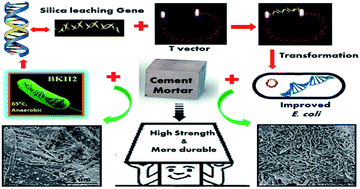Let’s talk good bacteria, and I don’t mean the kind in your yoghurt. No, I’m talking the kind in your concrete. Fear not, it is not a new breakfast craze. E. coli-based bioconcrete materials have been around for some time now, imbuing properties that allow cracks in the concrete to heal, improving the strength and durability of this material and also all lovely and green – reducing the overall energy cost and carbon dioxide generated in comparison to conventional processes.
Writing in RSC Advances, Manas Sarkar and co-workers have made the good bacteria even better by taking a gene from a bacterium that survives in hot springs, thriving at around 65 ˚C, amplifying it by PCR and implanting it in E. coli bacteria, engineering a unique strain. The gene in question is a silica leaching gene, which has previously been reported to impart higher compressive strength and durability. They add the gene into E. coli as these bacteria are easy to handle, effective at ambient temperatures and more efficient economically.

Concrete samples with the modified bacteria were shown to be 30% stronger than the control, thought to be in part a result of the protein producing a new silicate phase that fills the matrices of micropores in the material.
So, while you may think it a good idea to slather that crack in your ceiling with some probiotic yoghurt from the fridge – stand fast. The smarter bioconcrete is coming.
To find out more, click below to read the full article in RSC Advances.
Development of an improved E. coli bacterial strain for green and sustainable concrete technology
Manas Sarkar, Nurul Alam, Biswadeep Chaudhuri, Brajadulal Chattopadhyay and Saroj Mandal
RSC Adv., 2015, 5, 32175-32182











